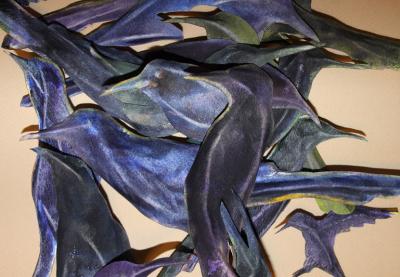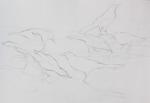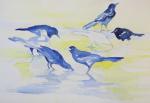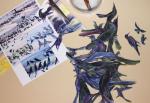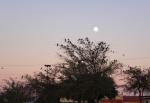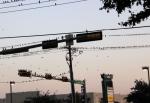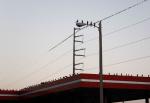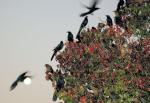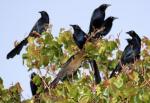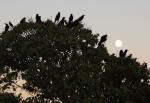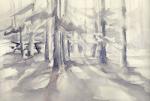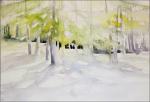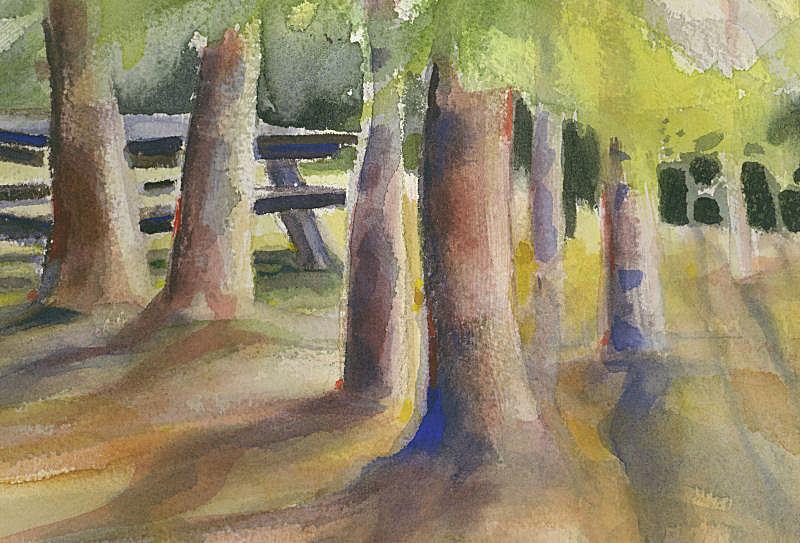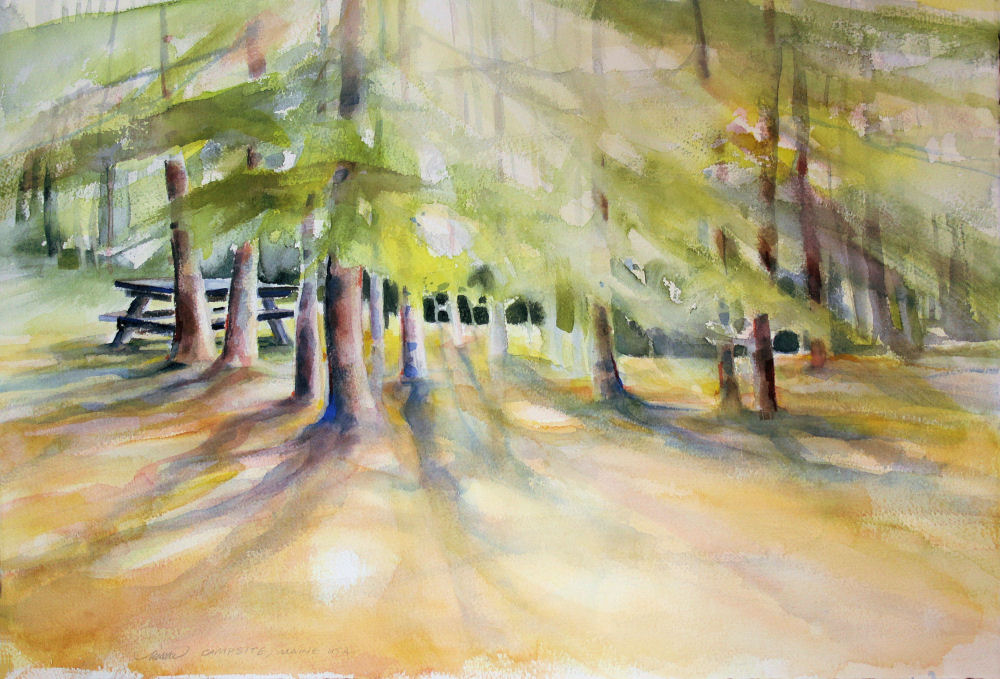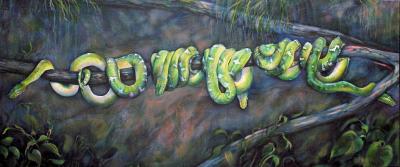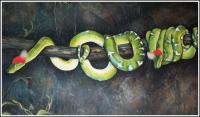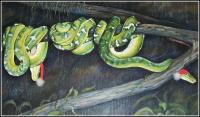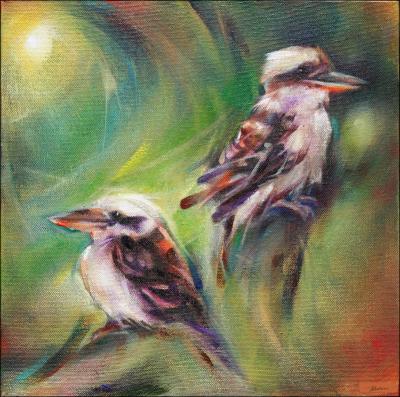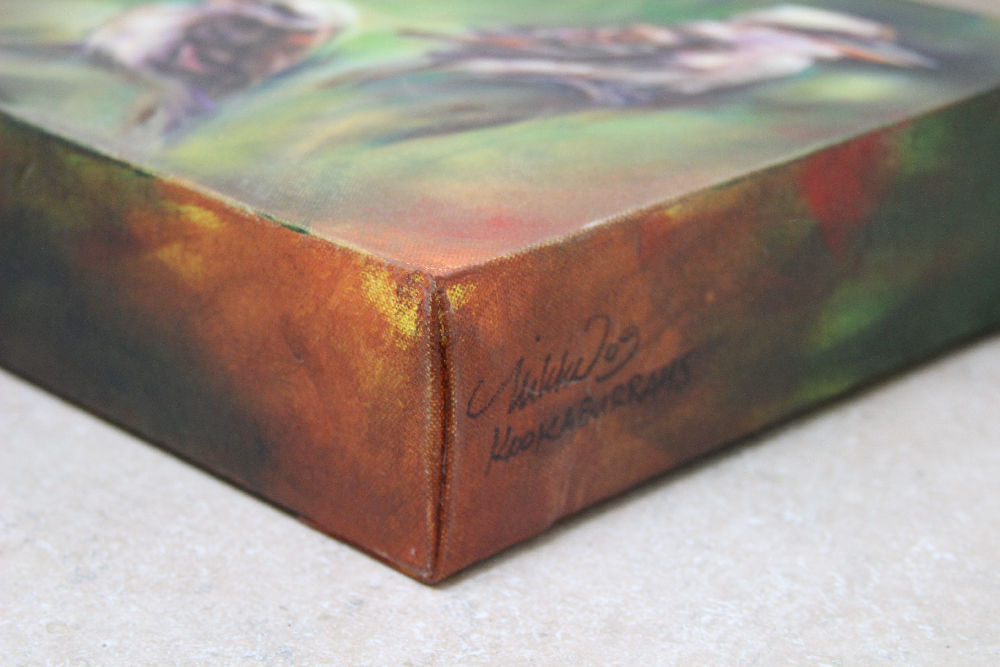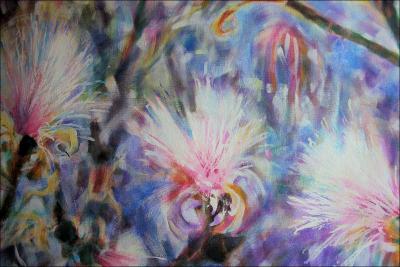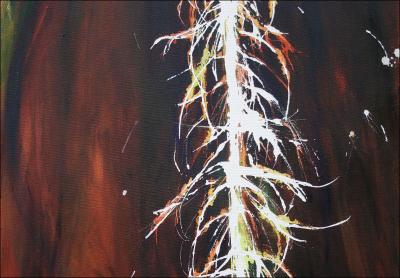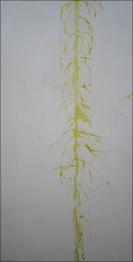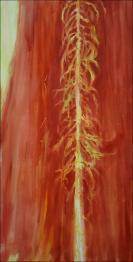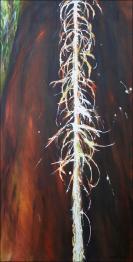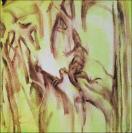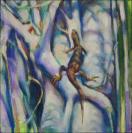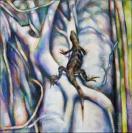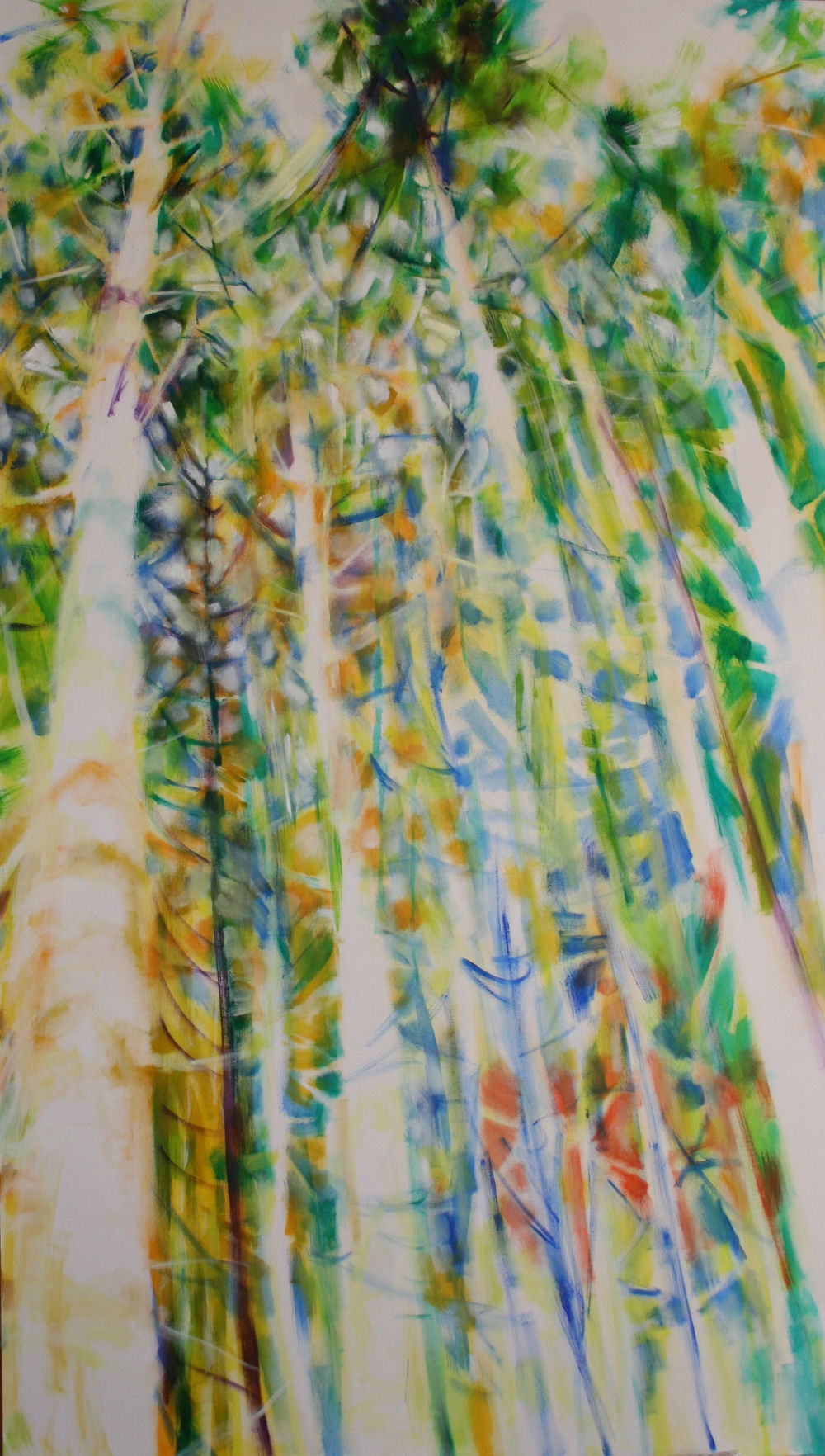work in progress
« Previous Entries Next Entries »Bird Party
Tuesday, November 17th, 2009
Bird Party, watercolors on molded 140 lb watercolor paper, work in progress.
I’m not exactly sure where this is headed, but shapes were cut out of the painting, the paper drenched, folded, stretched and sculpted. Every evening just before sunset in the Dallas-Fort Worth area Grackles, blackbirds, Starlings and pigeons gather on lawns, parking lots, overhead wires and cables, roofs and trees. The event is unique to this area as far as I know, and exciting beyond words to be amongst the thousands and thousands of birds. Here is a previous piece on the subject.
The Campsite
Wednesday, October 21st, 2009
Thumbnails: 1) Value sketch using Payne’s Gray 2) Oct 21st in progress 3) finished, left detail. This is the 2nd week of the watercolor course offered by Jo Williams.
The Campsite, Maine, USA – 15 x 22 inches Watercolors on 140 lb. acid free cold press premium paper, 22H x 28W” professionally framed, dark cherry wood with brass title plate.
Perpetual painting
Monday, October 5th, 2009
Like music
where silence between the notes sets the rhythm,
not painting is half the work.
 For all artists, the most mysterious question of all might be “is it finished?” , but for the sake of clarity and the examples here I’ll just refer to painters. One popular opinion is that the best painting is one that’s finished quickly; one that retains the artist’s first fresh impressions, otherwise it should be painted over or tossed in the garbage and a new one started immediately. There are solid reasons for not lingering too long on a painting, but in matters of the Art I’m always suspicious when I hear the word should being used in a sentence containing advice. Some art rumors are accepted as absolute when they could stand some explanation. It can be confusing enough for the experienced, but especially for beginners looking for ground rules and a map to follow.
For all artists, the most mysterious question of all might be “is it finished?” , but for the sake of clarity and the examples here I’ll just refer to painters. One popular opinion is that the best painting is one that’s finished quickly; one that retains the artist’s first fresh impressions, otherwise it should be painted over or tossed in the garbage and a new one started immediately. There are solid reasons for not lingering too long on a painting, but in matters of the Art I’m always suspicious when I hear the word should being used in a sentence containing advice. Some art rumors are accepted as absolute when they could stand some explanation. It can be confusing enough for the experienced, but especially for beginners looking for ground rules and a map to follow.
In Art though, for every should there is another option. The same suggestions don’t work for everyone. Have you ever felt guilty or embarrassed – even ashamed – because you took a painting too far? I have, but it’s only when I’ve compared my work and methods to others’ judgment that I should’ve quit while I was ahead…and guilt has no business hanging around in our daily work if it isn’t useful! Frustration can be an excellent motivator if it’s allowed to be.
If it’s going to make sense – not exclusively the sole intention – every painting reaches stages where we need to make the call to leave it alone and say it’s finished, or proceed; stages where placing one more mark means the entire painting has to change and be brought up to par around it. If things that need correcting are not dealt with honestly, the work will not be as successful as it could be. There are phases in each painting that are truly intimidating, when painting is anything but leisurely; when we’re faced with: do we climb that mountain or not?
A lot of Plein Aire artists swear that their methods of painting outdoors on-site produce the highest quality work. The limitations of sunlight, location, outdoor temperatures and so on, mean that to finish successfully they need to splash down a lot of information within a short period of time. Doing so, when the thinking brain is disengaged and just responding to the subject, a lot of amazing unintentional surprises show up in the painting. Spontaneity and spurts of enthusiasm for being fully in the present tense can bring great results that need no further efforts at the end of the day. Plein Aire artists are in a field of their own (literally too!).
It’s a curious thing how creativity warps and reforms into amazing things when pressure is applied. Many people who aren’t artists will agree that the greatest ideas can occur when under pressure to produce them. For those who have orders to complete, at its best the challenge is like a beautiful sort of panic, where there’s an understanding of the time restrictions while fully trusting that whatever needs to happen is going to be successful. The abilities are less trustworthy when the pace and demand for finished work increases, time allotted decreases and the quality of the product diminishes. If this imbalance continues over extended periods of time, like years, sloppy and care-less habits take hold too easily. If there is work that must be accomplished though, these things can be controlled to some extent –this is one benefit of pushing personal boundaries: it puts tenacity to practice – but creativity is fickle and that’s a fact.
What has all that got to do with the question about finishing? The best paintings are not necessarily those that are finished in a few hours or a day. There are other purposes for painting besides finishing it to admire, be admired or to sell. Nothing replenishes the quality of our creative energy like being lost in the timeless, pure enjoyment of study and detail for no reason in particular. “The Zone” is like an addiction where the high is fairly elusive but we’re compelled compulsively to track it down again and again, discovering and rediscovering the source of it all. One painting could be someone’s lifetime of work.
I’m saying that if you personally feel you’d like to keep going with a painting for days or years… or never finish, then you ought to follow your own intuition about it. I’m not saying you should. I just recommend considering what other artists say, but also consider each painting as a new experience with new rules, new goals and new circumstances.
Experience, masterpiece to failure, will always apply to future work somehow. That’s the great thing about painting: no time spent searching for answers is ever wasted. It’s all recyclable material! Every decision about finishing – or not – is relative to individuality, and relative to each new painting as it develops your way.
Pushing the boundaries
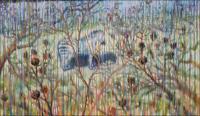 Myrtle At The Zoo, first version, Phase 18, unfinished – Crepe Myrtle branches and seedpods – 20 x 34 x 2 inches acrylics on canvas, gallery wrapped.
Myrtle At The Zoo, first version, Phase 18, unfinished – Crepe Myrtle branches and seedpods – 20 x 34 x 2 inches acrylics on canvas, gallery wrapped.
Work daily March 10th through April 2nd, 2008:
Finished for now…this one needs a rest, and I may or may not return to it. Regardless, I’ve learned a lot ad enjoyed playing with different ideas. It’s been interesting teetering back and forth between frustration and fun, but sometimes that’s what painting is all about. There’s been such a tension over this one as with no other painting, where the urge to throw it away is pitted against the determination to see what could happen. I still like a lot of things in it, such as the technique of dripping paint down the front that I’ve tried in previous paintings. Dripping re-energized the painting and me, and took the work in unexpected directions.
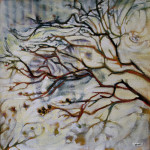 Myrtle At The Zoo, 2nd version – 11 x 11 x 3 inches acrylics on canvas, gallery wrapped sides painted. Many of the issues were worked through on the previous larger version, and I’m pleased with this boxy little painting…still not completely satisfied that I’m finished with this subject because it’s so complex, and it’s like a puzzle that’s nagging at me to figure out, so will probably attempt this same painting at least one more time.
Myrtle At The Zoo, 2nd version – 11 x 11 x 3 inches acrylics on canvas, gallery wrapped sides painted. Many of the issues were worked through on the previous larger version, and I’m pleased with this boxy little painting…still not completely satisfied that I’m finished with this subject because it’s so complex, and it’s like a puzzle that’s nagging at me to figure out, so will probably attempt this same painting at least one more time.
Perpetual painting
Painting animals with distinct and specific characteristics calls for a different approach from start to finish, for example, compared to generic landscapes. The boas are one of my favorite exhibits at the Dallas World Aquarium, downtown Dallas, Texas. The phosphorescent green skin has striking black and white scale patterns along the spine and a turquoise mother-of-pearl overall sheen that’s most visible at certain angles where the body delicately curls and bends, so this painting accumulates finer detail than is typical of my work, except in graphite illustrations.
Emerald Tree Boas, 24 x 57 x 2 inches acrylics on canvas, wrapped sides painted (August, 2005 – ? )
As shown in the thumbnail above, there are only a few small things left to do, a little on the skin then some barely visible brushstrokes in the background like ones that were there in earlier phases, thumbnail…so it really is just about finished, but I’m not in any hurry. Of course I’ll stop in my tracks if you want to buy it!
I like having one painting around that’s going to get the full treatment! Emerald Tree Boas has become like an old friend, even hanging out celebrating holidays in the dining room with the rest of us. It would be nice if this painting could carry enough potency to alter the automatic responses of fear and disgust that are associated with snakes. It just occurred to me that it might be fun to offer the buyer an assortment of hats and hearts and ribbons for different occasions. Where I used tape, instead I’d put magnets on the back and magnets on all the little hats and accessories. It’s a little nutty maybe, but it also opens up the target market a little doesn’t it!
Nature is perfectly imperfect. I paint with acrylics, so if the surface is washed back and scrubbed regularly in areas that need change. Scrubbing paint away with a pot scrubber or wet cloth used to remove paint helps texturize, give atmosphere, and also ensure that paint won’t cake up in areas, unless that’s the intention. More debates about spending too long on a painting are that it stiffens the whole look and feel because 1) it tidies things up too much, and 2) due to the plastic properties of acrylics, if they are allowed to pile up they will harden and shine, no longer catching the tooth of the canvas.
These are all things that can also be used to advantage though. In sports you need to know your opponent… well the same is true here. You can use the buildup to create the effects it produces if that’s what you want to achieve. To keep the canvas texture for as long as possible, paint diluted with gels or water is perfect to start, then as confidence builds, so can your applications of paint. My philosophy is that if things need to change they do, until the word “finished” is loud and clear.
…practice and even failure can be applied to future work…
Kookaburrahs
Saturday, May 23rd, 2009
Kookaburras, 11H x 11W x 3D inches acrylics on canvas, wrapped sides painted. Frame unnecessary. Hang on the wall or display on a flat surface. Most of the Magic Square series are signed on the side so as not to impose on the composition. Seen here, the signature is added digitally on the front.
March 13th, 2009 work progress blog post: This painting could have been left at phase 3, but the decision to give the birds more definition and sense of realism created a whole new set of problems. For example, the composition, which was unbalanced from the start, is now exaggerated and more noticeable, so a third element needs to be added in the upper left corner. Not necessarily another object but color or shape that would shift the weight and attention away from the lower left areas.
| Progress details: | |||
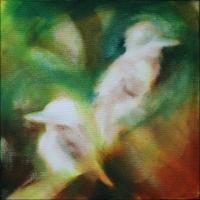 |
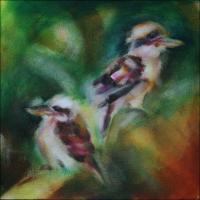 |
||
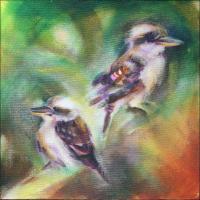 |
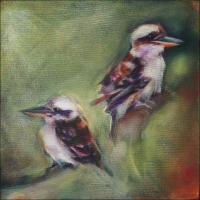 |
||
There is a work phase where, once details are added or changes made to one area, every other thing in the picture needs to be brought to the same level of quality: quality meaning style and feeling of the features. I don’t regret proceeding, but it does mean extra effort to solve all the new challenges, and usually while attempting to solve those new ones arise. Other professionals would say this is overworking, but it really depends on what your intentions are as an Artist, and what motivates the work. If risks are not taken sometimes, a painting may never be all that it could be. Phrases we tend to cling to like “less is more” are not written in stone; sometimes more is more…learning is a good thing!
In landscapes details are best left for the imagination, whereas painting animals, birds or other creatures, a purpose needs to be clearer. Is the intention to portray character through shape and silhouette? other traits? specific markings? Is it the main focus or only a part of the whole? Computer tools are also useful in playing with colors and other possibilities.
The perfect place for masking fluid
Monday, April 13th, 2009
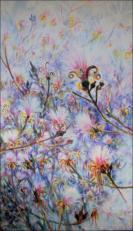 Flowering Shavingbrush Tree, April 11th above: details of 85H x 45W x 3D inches acrylics on canvas,wrapped sides painted, trim frame. Still in progress, but the rubberized mask was removed in order to see exactly what stage things are at before continuing. The painting overall still has a few areas to open up; very little work tomorrow should finish it. Shortly after starting the painting I turned it upside down and applied the masking fluid with a toothpick and let it drip. Gravity can be used as a tool!
Flowering Shavingbrush Tree, April 11th above: details of 85H x 45W x 3D inches acrylics on canvas,wrapped sides painted, trim frame. Still in progress, but the rubberized mask was removed in order to see exactly what stage things are at before continuing. The painting overall still has a few areas to open up; very little work tomorrow should finish it. Shortly after starting the painting I turned it upside down and applied the masking fluid with a toothpick and let it drip. Gravity can be used as a tool!
April 13th, Left: The top third will still leave as much of the primed canvas as possible; a gradation of unfinished space toward more finished at the bottom. I was hoping to leave it as seen here giving an airy illusion, but it does need to develop along with the rest of it…still not as much, but enough to show the main flower better. This means I’ll be once again dripping masking fluid on the piece upside down to preserve the interesting marks that occurred from the 1st application, and also create some new ones with any further work. For previous posts on earliest progress of this painting click here.
The Shavingbrush Tree
Thursday, April 9th, 2009
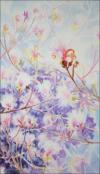 The Shavingbrush Tree in front of a flowering Jacaranda tree seen in Chapala, Mexico, 85H x 45W x 3D inches acrylics on canvas, wrapped sides painted, work in progress. Thumbnail, left: started March 31st
The Shavingbrush Tree in front of a flowering Jacaranda tree seen in Chapala, Mexico, 85H x 45W x 3D inches acrylics on canvas, wrapped sides painted, work in progress. Thumbnail, left: started March 31st
The last painting helped me more aware of how powerful contrasts of light and dark can be. Here, areas of primer will be purposely be left unpainted. I was going to just carefully avoid the white areas and paint around them, but during the second phase I dripped some of the masking fluid to block out a few details in the main flowers. Already it is a very different painting process-wise; right from the start it has felt like a complicated puzzle; that stage doesn’t usually appear until near finishing. The first stages of painting are usually the most liberating but since I never pencil in an outline before painting, I fought a lazy brain right from the start that did not want to map out the placement… which doesn’t make sense because I really really want to paint this one! These are not typically the colors I use either, so there are a few intimidating factors. I hope to maintain fresh, bright Easter colors — partly because this is when they bloom in Mexico. Painting is much like a runner hitting “the wall” but persevering and breaking through it…however in painting there are many walls to conquer.
Oxide Gallery
There are a few pieces hanging at Oxide Gallery, Denton, TX for the next three months: Rocky Mountain Vista, Zen Garden #6, and all four recent encaustic works.
Using masking medium
Friday, March 27th, 2009
Grand Fir in front of a giant Sequoia, 48H x 24W x 2D inches acrylics on canvas, using masking medium to outline the mossy dead branches.
Some work, some don’t, but I haven’t given up on it yet; work still in progress, but since this won’t be in the Raleigh show in 7 weeks I can’t afford to spend more time on it now. I hoped the flat white would work against a fairly realistic background, but it doesn’t. This could go a few ways: 1) flatten the whole surface and make the painting an abstract 2) downsize the sequoia, add shadow and color to the fir then create a more realistic forest scene 3) block out more dead firs with more masking fluid, echoing the main one, still as an abstract or realistic or 4) ditch it! Some paintings are worth spending time exploring when they reach a certain stage, and with others chalk it up as experience, re-cover the stretcher frame and move on.
Iguana and Strangler Fig
Wednesday, March 18th, 2009
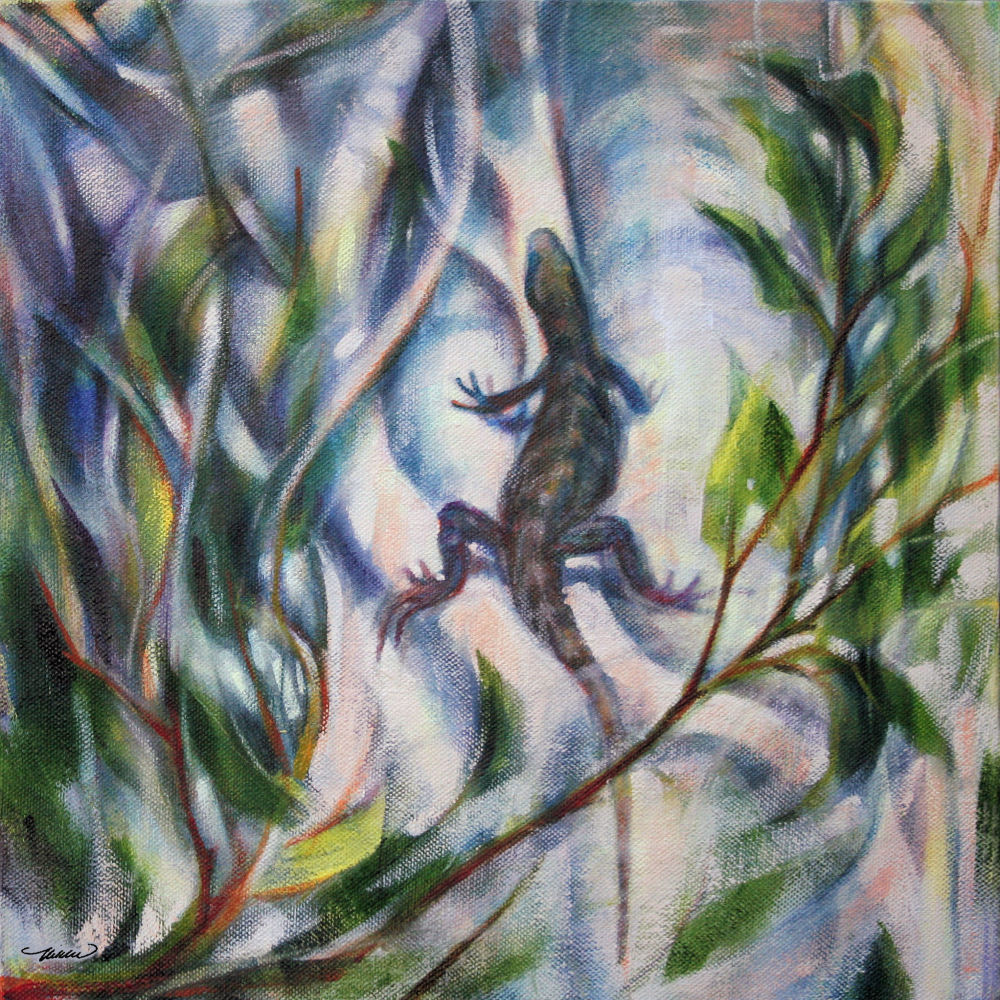
Iguana and Strangler Fig, Costa Rica, 11H x 11W x 3D inches acrylics on canvas, wrapped sides painted. Frame unnecessary. Hang on a wall or display on a flat surface.
The Strangler Fig is a parasite. Seeds sprout in moss or decaying matter among the branches of rain forest canopies. Roots gradually extend downward and over time completely surround the host tree, which dies while nourishing the Strangler Fig growing in its place.
March 14th, March 13: Phases 1, 2 and 3 earlier progress in thumbnails below. Today layering thin washes of pale yellow, placing the iguana more into the background. Some of the details of the Strangler Fig growth that are now covered up might be brought back into focus since this is more about the tree than the iguana. Posting the painting on the blog is helpful because it’s viewed differently than while painting or studying it. It’s somehow easier to see areas that still need change when looking at it on-screen.
Method reflected by purpose
Friday, January 30th, 2009
 Left: Hemlocks, Queen Charlotte Island, 1980 – 48 x 48 x 2 inches
Left: Hemlocks, Queen Charlotte Island, 1980 – 48 x 48 x 2 inches  acrylics on canvas, painted plein air. Right: Birch, 1993 – 6 x 4 watercolors. I have been trying to return to the same carefree approach I painted with during the earlier years. While some of my first paintings were a little on the sloppy side, the look and feeling of life in the work comes through the first reactive sloppy-looking brushstrokes. Too much refining tones down that energy. It has taken about six years to rid myself of a lot of habits that developed by painting murals, like tidying up too much and mixing colors on the palette as opposed to just throwing the color onto the canvas. Not that mural painting is valued as less than canvas paintings, but they require entirely different methods, and because their intended purpose is slightly different, so is the approach to painting them. Switching back to canvas now, even if the surface is large it’s taken six years to re-adapt to the process of painting on canvas. All that I think I know can get in the way sometimes. In Dancing With Trees 03 I’m rediscovering some of the joy that pushed everything forward in the first place. Virginia, you say that this sings and dances…well, that’s exactly how I feel while painting this one.
acrylics on canvas, painted plein air. Right: Birch, 1993 – 6 x 4 watercolors. I have been trying to return to the same carefree approach I painted with during the earlier years. While some of my first paintings were a little on the sloppy side, the look and feeling of life in the work comes through the first reactive sloppy-looking brushstrokes. Too much refining tones down that energy. It has taken about six years to rid myself of a lot of habits that developed by painting murals, like tidying up too much and mixing colors on the palette as opposed to just throwing the color onto the canvas. Not that mural painting is valued as less than canvas paintings, but they require entirely different methods, and because their intended purpose is slightly different, so is the approach to painting them. Switching back to canvas now, even if the surface is large it’s taken six years to re-adapt to the process of painting on canvas. All that I think I know can get in the way sometimes. In Dancing With Trees 03 I’m rediscovering some of the joy that pushed everything forward in the first place. Virginia, you say that this sings and dances…well, that’s exactly how I feel while painting this one.
Dancing With Trees 03 work in progress, 85H x 45W x 3D inches acrylics on canvas, sides painted
Logic is one-dimensional, creativity is not
Monday, January 19th, 2009
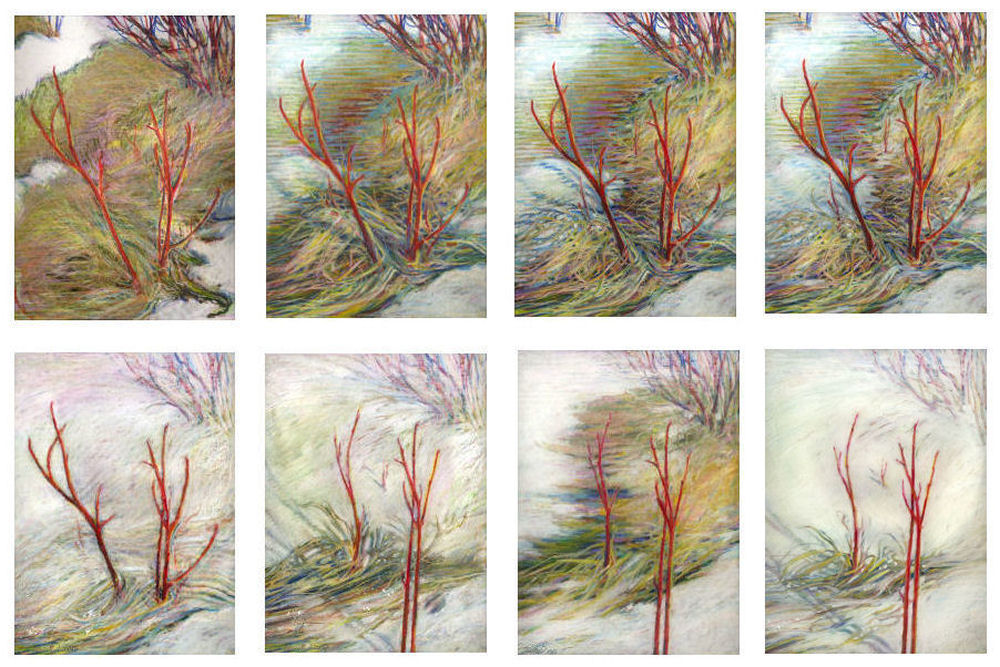 There are at least four active projects on the go here, and that’s the case with most artists. Because creativity is all-encompassing, and when the unpredictable nature of it is revealed on a daily blog, a defining statement or mission and re-evaluating it every once in a while is all-important.
There are at least four active projects on the go here, and that’s the case with most artists. Because creativity is all-encompassing, and when the unpredictable nature of it is revealed on a daily blog, a defining statement or mission and re-evaluating it every once in a while is all-important.
* Career artists do not generate production like a factory or have the same business formulas and game plans as retailers; for us everything from conception to sale is self-prompted. Motivation to work every day on something often means doing something different every day. I give myself the guilt-free permission to do whatever I want at on any given day. However…
* One main piece of work needs to be on the plate always, and the others are like a sort of coffee break; the mind needs to think of other things for a bit then return to the main work with new perspective.
* About faith and fortitude: eventually things are finished one after the other, some in one day, some not…but every day no matter what, if one puts forth effort even with no results, then something is still accomplished.
* Self-discipline: if a client is expecting an original concept and a complete product within 48 hours, then absolutely: results can be forced. Within that limited time frame, the usual way of working and thinking becomes temporarily chaotic; a difficult process for some, because presupposed thoughts have to scatter and previously-done ideas need to be let go. At some point, maybe with only one hour left – crunch time – trust that chaos regroups into something totally new and unexpected..the best, most rewarding work can occur during these times. In other words, here’s how anything is created: you’ve gotta be willing to go a little kooky if you have to, but always be alert to reason and bring a thing into reality!
* We have long-term goals and short-term goals, and mini-goals within the short-term ones, but the process is one and the same: shifting the usual and expected way of thinking – or working – is the best way to regenerate creativity on a consistent basis.
« Previous Entries Next Entries »

